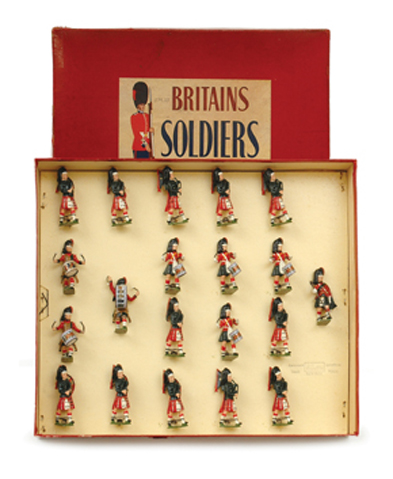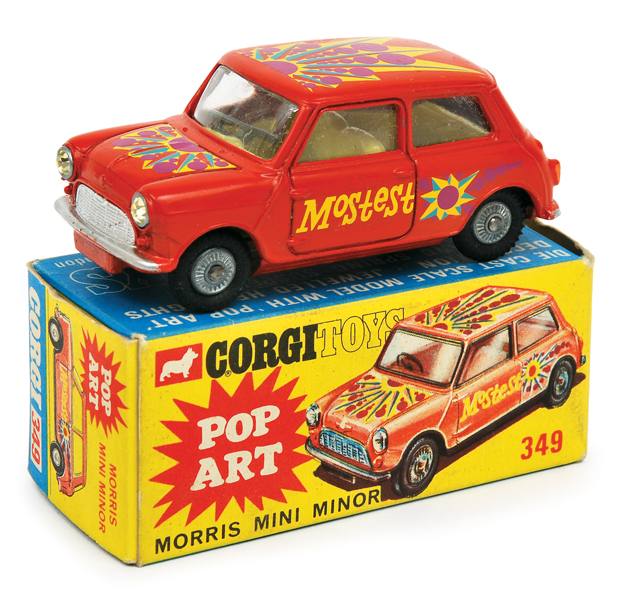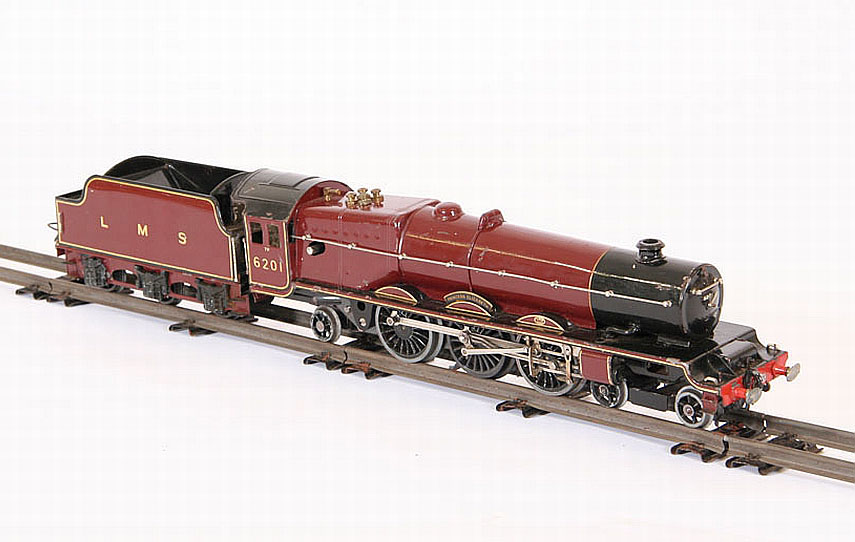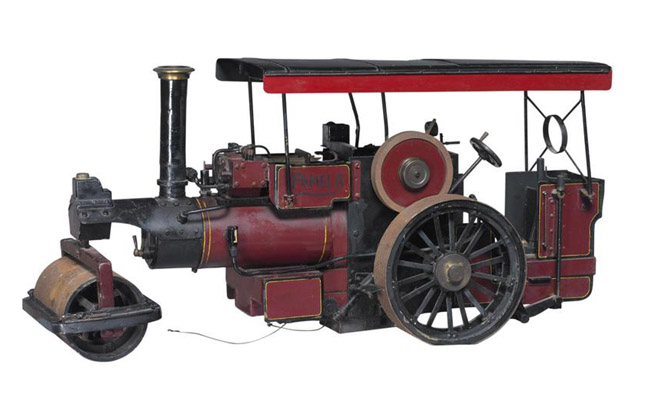Learn about antiques and collectables...
Click on a category below to show all the entries for that category.
Learn about and understand the items, manufacturers, designers and periods as well as the specialist terms used in describing antiques and collectables. Either click one of the letters below to list the items beginning with that letter, or click on a category on the left side of the screen to list the items under that category.
Britains
Britains was established c1860 by William Britain (1826 – 1906) in northeast London and, in the early 1890s, began to specialize in the manufacture of toy soldiers.
Britain’s son William Britain Junior (1860 – 1933) is credited with having invented the hollow casting process which, and in 1893 applied it to the manufacture of toy soldiers, giving the company a competitive edge.
By 1906 virtually all the toy soldiers in the Christmas catalogue of the London toy store Gamages that supplied toys by mail order all over the world were made by Britains. They were marketed as "English-made", giving them a competitive edge over toys made in Europe.
The hollow cast figures, being of a standard size were ideal for war simulations, and Britains were renowned for the accuracy of uniforms and equipment.
The models were sold in high gloss bright red boxes and having the original packaging adds to the value for a collector.
By the 1960s plastic had become the predominant material of manufacture and in 1966, due to safety regulations and the high manufacturing cost, production of hollow cast figures came to an end.
Throughout the 1960s, ’70s and ’80s Britains continued, producing a range of plastic farm animals and complementary diecast vehicles, and in the ’90s introduced a new range of metal toy soldiers in the old traditional uniforms.
In 1997 Britains was purchased by the Ertl Company, Germany, and after another change of ownership, was purchased in 2005 by First Gear, an American company that makes die-cast collectables. The models are still sold under the W. Britain brand.
Chad Valley Toys
Chad Valley is a toy company that was founded in the United Kingdom in the late 19th century. It is known for producing a wide range of toys and games for children, including dolls, action figures, board games, and puzzles. Chad Valley toys are known for their high quality and durability, and they are popular with children and collectors alike. The company was originally founded by Arnold Lowe as a small toy shop in Birmingham, England and it quickly grew in popularity and began producing its own toys, which were sold both in the UK and abroad. In the 1920s, Chad Valley became one of the largest toy manufacturers in the world, and it continued to expand throughout the 20th century. Today, Chad Valley is still a well-known and respected brand in the toy industry.
Chiltern Toy Works
Chiltern Toy Works was a British toy manufacturing company that was active from the late 19th century to the mid-20th century. The company was based in High Wycombe, Buckinghamshire, and specialized in the production of lead and cast iron toys, including trains, automobiles, and other vehicles. They are known for their intricate and detailed designs, and many of their toys are considered to be highly collectible today. Chiltern Toy Works was one of the largest and most well-known toy manufacturers in Britain during its time and its products are still highly sought after by collectors. The company was taken over by Chad Valley in 1967.
Corgi Toys
Corgi Toys were produced by Mettoy Playcraft from 1956. Made in Swansea, South Wales, they were named after the Welsh dog, the favourite breed of the Royal family. The name was short and snappy like that of their intended rival, Dinky, and both Mettoy and Playcraft were based in Swansea, Wales giving it added relevancy.
Die cast vehicles were of a very high standard and came with many attractive features – plastic windows (Dinky cars had open windows) and from 1959, spring suspension and detailed plastic interiors.
The early ’60s saw the introduction of ‘jewelled’ headlights and opening doors and boots.
One of the first ranges produced was the Chipperfield Circus range in 1960, and in 1964 the Corgi Classics range of veteran and vintage cars.
This focus on moving parts and features made Corgi the natural choice to produce James Bond’s gadget-packed Aston Martin DB5 in 1965, one of the most popular toys ever made with sales of nearly three million.
A host of other film-and television-related toys followed such as the Batmobile and The Man from U.N.C.L.E. car (1966) ; The Avengers’ Bentley and Lotus Elan and the Green Hornet’s Black Beauty (1967); Chitty Chitty Bang Bang (1968) and many others, including further Bond cars.
In 1970, Corgi introduced their Whizzwheels line to compete with Mattel’s hugely successful Hotwheels series.
As a result of competition, particularly from US company Mattel, and a fire at the Swansea factory the company got into financial difficulties in 1983, resulting in a management buyout the following year. Five years later, Corgi was acquired by Mattel, followed by another management buyout in 1995 and then the sale of the company to American collectables manufacturer Zindhart, which changed its name to Corgi International.
In 2008 Corgi International came back into British hands when it was acquired by Hornby Hobbies Ltd.
Diecast
The toy is made by by pouring molten metal into a closed metal die or mould. The first metal used was a lead alloy, but the finsihed product was very soft and broke easily, and was replaced with an alloy of zinc mixed with small amounts of aluminium and copper.
Friction Motors in Toys
A friction motor, also known as a push and go is a type of motor that uses friction to create motion. It is commonly found in toys, particularly in vehicles such as cars and trains. The motor works by using a spring-loaded mechanism that is activated when the toy is pushed or pulled along a flat surface. The movement of the toy causes the friction between the wheels and the surface to turn the gears inside the motor, which then propels the toy forward.
Friction motors are known for their simplicity and low cost, making them a popular choice for children's toys. They are also easy to use, as they do not require any batteries or electrical power to operate.
However, there are some drawbacks to friction motors. They can wear out over time, especially if the toy is used frequently. They also have limited speed and power, and the motion can be affected by the surface on which the toy is used.
Gauge
The first model railways had a track width of 48mm (1.89 inches) which was named 1 gauge. With smaller key-wind locomotives a narrower gauge was introduced, call 0 gauge, and then in the early 20th century "half 0" (or HO) gauge was introduced. In Britain and the Commonwealth countries this was called "00" gauge.
Hornby
Frank Hornby (1863-1936) the inventor of 'Meccano' was also responsible for the introduction in about 1915-20 of the clockwork train sets that bear his name.
Electric powered Hornby trains first appeared in 1925. The Hornby trademark was used until 1940 when all construction of Hornby trains was halted with the onset of World War II.
Production of the toy trains resumed in 1946, though in the immediate post-war years, a general shortage of raw materials restricted production. Hence, new toy trains items were not introduced until the early 1950s.
By the late 1950s, when construction of plastic toys begun, sales began to decline, and in 1965, Hornby was taken over by Tri-ang (Lines Brothers), who incorporated some items from the Hornby line into its catalogue.
Meccano
For those boys who grew up in the 1950s and 1960s, a Meccano set was the equivalent to today's Xbox or Nintendo.
Meccano Ltd was invented by Frank Hornby, a young clerk who worked for a meat importing company in Liverpool, after his idea in 1901 of a new toy - 'Mechanics Made Easy'. This very quickly became known as Meccano, and was soon on sale across the world.
'The Meccano Magazine' - a monthly newsletter - was introduced in 1916 and contained articles of interest to budding engineers. It included new plans for models which could be assembled with Meccano, often requiring the purchase of additional parts or a larger outfit.
At its peak The Meccano Magazine enjoyed a circulation of 50,000 and was published until 1980. Apart from development of new and modified components, Meccano underwent colour changes on many occasions - some of which reflected the mood of the time.
For example in 1936 it was produced in royal blue with gold cross-hatching to mark the coronation of King George VI following the abdication of his brother, Edward VIII; in 1939 with he impending World War, Meccano was produced in matt green similar to the colour of military vehicles then in common use.
By the end of the 1930's Meccano was being produced under license in France, Germany, Spain, and the USA.
The advent of television and then later, computers, made a serious dent in the popularity of Meccano (and many other practical hobbies) and Meccano ceased production at its Liverpool factory in 1979. The French producer of Meccano bought the worldwide rights, stepped up production and relaunched the company as Meccano SA.
Meccano is currently enjoying a worldwide resurgence of interest due, paradoxically, in large part to the computer and the internet. An internet search on the keyword 'Meccano' reveals a large number of web sites dedicated to the hobby and Meccano clubs are still found in many countries.
Scratch Built
A scratch built model is one that is built "from scratch", i.e. from the raw materials, rather than one purchased and built from a kit of parts, or purchased pre-assembled.
Steam Engines and Models
Steam has been used to power models and toys from the late 19th century onwards, as an alternative to clockwork. It was largely replaced by battery or electric power in the 20th century, although some toys are still being sold and some models (usually scratch built by amateurs) are still being built.
There are three primary types of steam engine driven items: stationary toys built for children, moving steam-powered models such as engines, trains and boats and demonstration models made to show how a machine works.
Stationary engines were made by many of the leading German tinplate manufacturers such as Gebruder Bing, Marklin, Ernst Plank and Carette. In England, Mamod is the best known maker. They also made moving steam engines. Most stationary steam engines drove flywheels that would be attached to other accessories with belts, driving the workings on the accessory. Factories, windmills and other novelty movements can be found. Tinplate toys are desirable to tinplate collectors who collect names such as Marklin and Bing.
Original paintwork or lithography is important, and damage, often caused by the water and oil used, reduces value. Look for original burners and components. Larger demonstration models fetch large sums if sophisticated, well engineered and of a large size. Any finely made ‘live steam’ pieces such as trains that can be ‘ridden’ or are larger than a toy will also usually be desirable and valuable.




